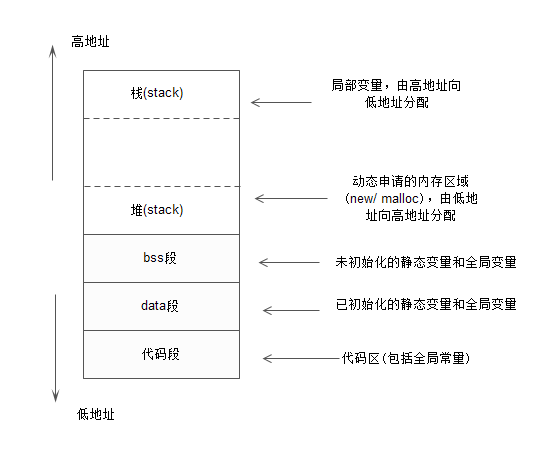每个linux进程在被创建的时候,都被分配给一段内存空间,即系统给该进程分配一定的逻辑地址空间(VM),通常32位CPU的寻址空间是2^32=4G,所以理论来说一个进程的最大逻辑地址空间为4G,其中有1G是内核代码段。而另外一部分则分为代码段和数据段,数据段又可分为data\bbs\stack\heap等。具体的分配情况如下图所示:

在编译阶段可以确定的是text\data\bss段的大小。
如下的测试代码可以清晰看出变量和常量的内存分配位置:
1 #include <iostream> 2 using namespace std; 3 //未初始化全局变量,bss段 4 int g_uninit; 5 //初始化的全局变量,data段 6 int g_init = 100; 7 int main(int argc, char* argv[]) 8 { 9 //初始化静态变量,data段 10 static int s_init = 100; 11 //未初始化静态变量,bss段 12 static int s_uninit; 13 //局部变量,栈中 14 int l_temp = 0; 15 //局部变量,栈中 16 int l_temp1; 17 18 //变量p本身存在栈中,p指向代码段的一个地址 19 char *p = "Test Mem"; 20 21 //动态分配,堆中 22 char *n_p = new char[20]; 23 24 25 //main入口地址,代码段 26 cout << (int*)main << endl; 27 //p所指向地址,即"Test Mem"存放位置,代码段 28 cout << (int*)p << endl; 29 //p存放位置,栈中 30 cout << &p << endl; 31 32 cout << &g_uninit << endl; 33 cout << &g_init << endl; 34 cout << &s_uninit << endl; 35 cout << &s_init << endl; 36 cout << &l_temp << endl; 37 cout << &l_temp1 << endl; 38 39 return 0; 40 }
输出结果:
注:全局const常量通常是以立即数的形式在编译时直接加入到指令中,而局部const常量则是存放在函数栈中。验证程序:
1 #include <iostream> 2 using namespace std; 3 4 const int g_c=100; 5 int g_init = 100; 6 int g_uninit; 7 int test(); 8 int main(int argc, char* argv[]) 9 { 10 const int l_c = 20; 11 cout << &l_c << endl; 12 cout << (int*)main << endl; 13 cout << &g_init << endl; 14 cout << &g_uninit << endl; 15 cout << &g_c << endl; 16 cout << (int*)test << endl; 17 return 0; 18 } 19 int test() 20 { 21 return 0; 22 }
编译执行,输出:
P.S 可以使用命令size来查看编译时可确定的内存段大小: